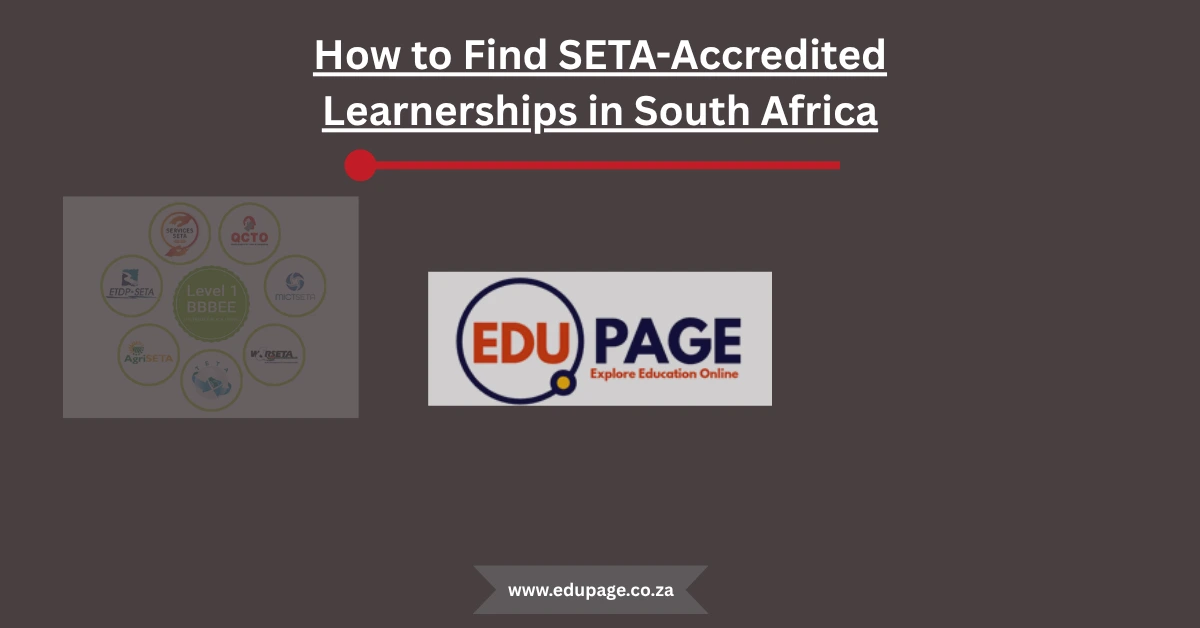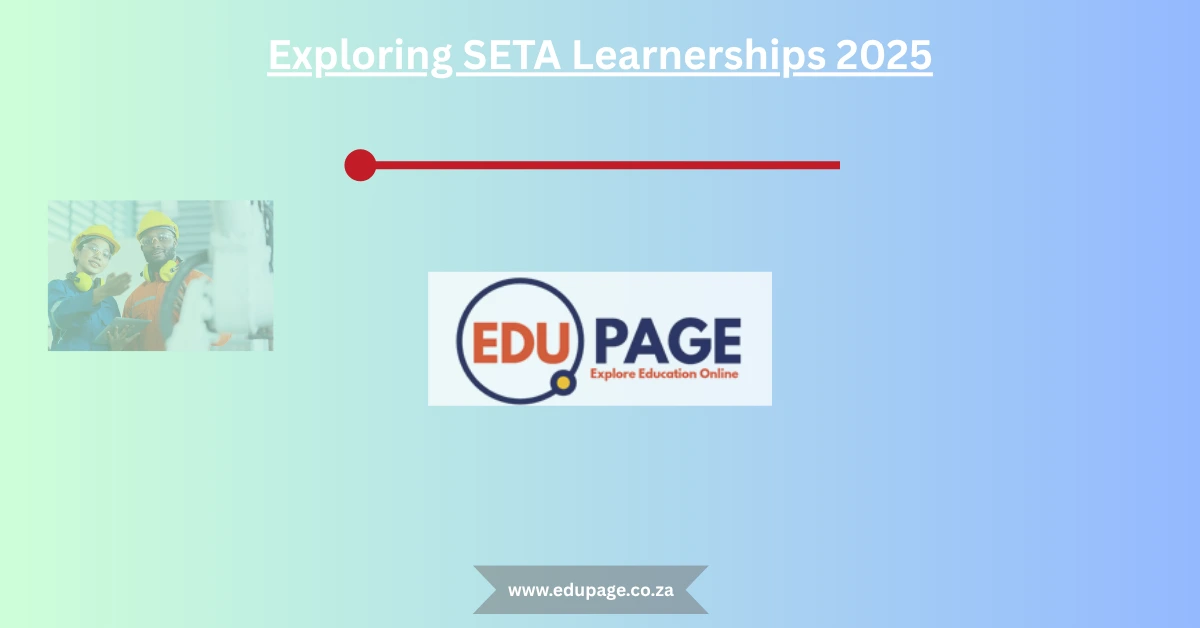SETA Bursaries in South Africa: Understanding the Support Behind Your Skills Journey
A Question Many Young South Africans Ask: Is SETA a Loan or a Bursary?
In South Africa, navigating the world of post-school education funding can feel like walking through a maze. There are NSFAS bursaries, student loans, private funding, and then—there’s SETA. But what exactly is SETA? More specifically, is SETA a bursary or a loan?
This question comes up frequently among learners and parents trying to secure a brighter future through education. The short answer is simple: SETA offers bursaries, not loans. But understanding how these bursaries work, who qualifies, and what makes them different is crucial—especially in a country where skills development is the bridge to employment.
📘 What Is SETA and Why Does It Exist?
SETA stands for Sector Education and Training Authority, and it plays a vital role in South Africa’s education ecosystem. Established under the Skills Development Act, SETAs are responsible for ensuring that skills training meets the needs of industry sectors like:
- Engineering and Manufacturing (MERSETA)
- Finance (BANKSETA)
- Media and IT (MICT SETA)
- Services (SERVICES SETA)
- Agriculture (AGRISETA)
- And many more.
Each SETA is tasked with identifying scarce and critical skills within their sector and funding training programmes to close those gaps.
In short, SETAs don’t just offer financial aid. They build skills pipelines to help South Africa grow economically—and to help you get trained for a job that matters.
💡 So, Is SETA Funding a Bursary or a Loan?
Here’s the key point:
SETA funding is a bursary—not a loan.
This means:
- You don’t have to repay it.
- It’s awarded based on financial need and sectoral demand.
- It’s intended to support unemployed individuals (especially youth) who have already been accepted into accredited courses—most commonly TVET Colleges.
- It’s aligned to specific programmes that address scarce or critical skills.
This is not like a commercial student loan or even like NSFAS loans from years past, which required repayment. With SETA, the goal is empowerment, not debt.
🎯 Who Qualifies for a SETA Bursary?
SETA bursaries are targeted, not universal. You won’t automatically qualify just by enrolling at a college. Your eligibility depends on:
- Being unemployed (especially young, previously disadvantaged individuals)
- Being accepted into an accredited institution, such as a public TVET college or a university of technology
- Studying in a field identified as scarce or critical within a specific SETA sector
- Meeting academic and financial criteria set by the particular SETA
For example:
- MICT SETA may fund IT-related programmes like Systems Development or Data Analysis.
- AGRISETA may focus on bursaries for agricultural science or farming-related studies.
- SERVICES SETA could support fields like Business Administration, HR, or Tourism.
If your study area aligns with the sector needs of a particular SETA, your chances of qualifying are much higher.
💰 What Does a SETA Bursary Typically Cover?
While bursary packages vary from one SETA to another, most include:
- Tuition fees paid directly to the college or university
- Prescribed learning materials (e.g., textbooks, software)
- Transport and/or accommodation support, especially for rural learners
- In some cases, a monthly stipend to assist with living expenses
This support can be full or partial, depending on available funding and the scope of the programme.
🛠️ Real-Life Example: Thabo’s Journey with a SETA Bursary
Thabo, a 20-year-old from the North West Province, dreamed of working in engineering. After high school, he was accepted into a Mechanical Engineering programme at a public TVET college but couldn’t afford the tuition or travel costs.
Through his college’s student support office, he was introduced to the MERSETA bursary programme. His application was approved because:
- His course aligned with MERSETA’s skills demand
- He came from a low-income household
- He had achieved good academic results
Today, Thabo not only completed his course debt-free, but he’s also been placed in an apprenticeship programme, with the possibility of full-time employment at the end.
His education cost him nothing—but it changed everything.
🧾 SETA Bursary vs. Loan: Understanding the Difference
| Feature | SETA Bursary | Loan (e.g., Bank or NSFAS Loans) |
|---|---|---|
| Repayment Required | ❌ No | ✅ Yes |
| Based on Academic Merit | ✅ Usually | ✅ Yes |
| Based on Financial Need | ✅ Yes | ✅ Yes |
| Interest Charged | ❌ No | ✅ Yes (usually compounded annually) |
| Linked to Sectoral Needs | ✅ Yes | ❌ No (generic study support) |
| Administered By | Specific SETA Authorities | Banks, NSFAS, or private institutions |
| Placement Opportunities | ✅ Often Includes Job Pathways | ❌ Not Guaranteed |
🌍 The Bigger Picture: Why SETA Offers Bursaries
SETA bursaries aren’t just charity—they’re part of a national strategy to fight unemployment, uplift communities, and grow the economy.
Here’s how:
- South Africa faces a major skills mismatch—jobs exist, but the right people aren’t trained for them.
- Employers in various sectors are desperate for skilled workers—from welders and coders to agricultural scientists.
- SETAs invest in training people in those skills, bridging the gap between learning and employment.
This is why SETA bursaries don’t fund just anything. They fund what matters—what leads to work.
🧭 How Can You Apply for a SETA Bursary?
- Identify your field of study.
Match it to a sector (e.g., HR = Services SETA, Finance = BANKSETA). - Visit the relevant SETA website.
Each SETA advertises its own bursary opportunities annually. - Check eligibility criteria and open dates.
These vary by SETA and by year. - Prepare your documents.
Common requirements include:- Certified ID
- Academic records
- Proof of acceptance
- Motivation letter
- Proof of unemployment or household income
- Apply before the deadline.
Most SETAs open applications between September and January each year.
Pro Tip: Many TVET colleges and career guidance centres help students apply—don’t be afraid to ask.
🧠 SETA Bursaries and Skills Development in the Fourth Industrial Revolution (4IR)
As South Africa moves deeper into the Fourth Industrial Revolution (4IR), SETA bursaries are increasingly focused on future-ready skills:
- Digital literacy
- AI and data science
- Green energy
- Advanced manufacturing
This means that learners receiving SETA bursaries today are preparing for the jobs of tomorrow—making this form of funding one of the smartest investments in national development.
✨ Final Thoughts: SETA Is a Bursary With Purpose
Let’s go back to the original question:
Is SETA a bursary or a loan?
It is a bursary—but more than that, it is a commitment to transformation.
It is education without the burden of debt, specifically targeted to grow industries, empower individuals, and build South Africa’s future.
For young people hungry to learn, unemployed adults seeking a second chance, or parents hoping to give their children a better life, a SETA bursary could be the opportunity that turns potential into progress.
So, if you’ve been asking whether SETA is a loan or a bursary—now you know. It’s a lifeline, not a liability.
Would you like this turned into a blog page for your SSETA website or formatted as a downloadable guide for learners? Let me know—I’m ready to assist.



